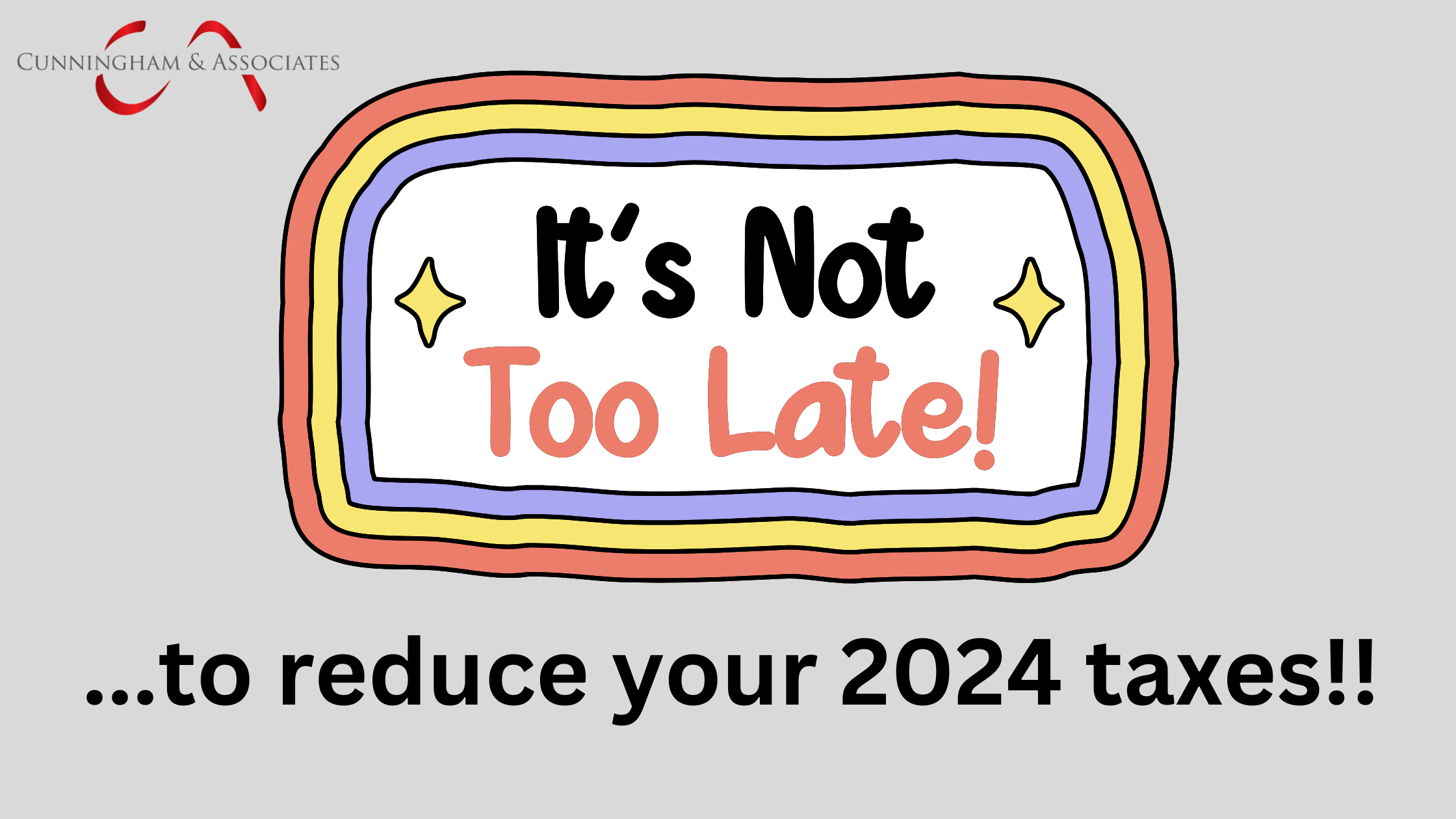"Golf is deceptively simple and endlessly complicated."
Arnold Palmer.
The same can be said about taxes.
Few want to talk about them (except us) and absolutely no one wants to pay them. At C&A, we truly believe that most people and business owners overpay their taxes due to a basic lack of information and understanding.
It's ok, it's not your fault.
You have your businesses to run, your family to protect and your dreams to pursue. Taxes are painful, something you need to "get done” not something you have the time or resources to strategically use to your advantage.
For most tax preparers, the mindset is the same, their job is to get them done, and they don't have time to focus on the big picture.
At C&A, We see the big picture. It's why we talk so much about "empowering the informed taxpayer". We help our clients make truly informed, strategic decisions that have massive financial impacts. We do this through research, decades of experience, deep knowledge of the tax code, and a willingness to get to know our clients, their goals, and their dreams.
There are 75,000 pages in the tax code and it is constantly evolving, but when you take a step back, there are just 4 simple pillars of tax reduction; income tax, executive compensation & benefits strategy, tax efficient investing, and exit and estate planning.
Let’s take a minute to explore each.
1. Income Tax Reduction
"The hardest thing in the world to understand is the income tax"
Albert Einstein
When we talk about income tax reduction, we are talking about using the tools and tactics available to us to increase cash on hand to invest in growing your business through R&D, hiring, or real estate. Or maybe you just want to buy a boat. And, if done correctly, we can use those investments to greater advantage and fuel further investment (maybe not the boat).
Here are some of the areas we consider.
1. Credits and Deductions:
There are a variety of credits for businesses and individuals that can directly reduce your tax dollar-for-dollar. The key is to be sure you know they exist and to apply them legally. The same goes for deductions, when applied thoughtfully and creatively, the impacts can be enormous.
2. Entity Structuring:
Selecting the right entity structure can significantly impact your taxes. For example, pass-through entities like LLCs avoid double taxation, where profits aren't taxed at the business and owner level. Your entity structure, like many other elements of your financial strategy, should be reviewed regularly to align with your goals and current situation.
3. Accounting Elections:
Close to a decade ago one of the most sweeping sets of changes in the history of the tax code was introduced, dramatically increasing the options available to businesses (particularly those making $29 million or less annually). Your accounting methodology, like your entity structure and individual tax situation, should be reviewed and adjusted to ensure maximum benefit.
2. Executive Compensation & Benefits Strategy
"Taxes are paid in the sweat of every man who labors."
Franklin D. Roosevelt
We work with many business owners who believe that since they own the company, their salary should be the highest. This isn't always the case. We focus on optimizing compensation structure to maximize after-tax income. This strategy focuses on structuring compensation to minimize taxes paid by the owner. This may involve a combination of salary and bonuses for performance, tailored to maximize tax benefits based on the business structure. Additionally, sharing profits directly with the owner can be tax-efficient for pass-through entities like LLCs or S corporations.
Similarly, business owners often overlook how their benefits plans are much more than an employee incentive but an asset that can be leveraged for the owners benefit. When plans are developed in a more owner centric way, owners can reap the benefits of reduced costs and increased contribution limits. These plans are designed to reduce out-of-pocket expenses for the owner by covering expenses with pre-tax dollars, ultimately lowering taxable income and increasing net worth. For example, offering health insurance through the business can be tax-deductible and help reduce personal healthcare costs. Moreover, providing term life insurance and disability insurance funded by the business can offer financial security for the owner and their family at a tax-deductible cost. Not to mention the incentives available to owners for setting up new plans.
When combining a strategic owner compensation plan with owner-centric benefits, business owners can achieve several key benefits. This includes increasing after-tax income to boost net worth, reducing personal expenses through pre-tax benefits, and planning for the future by utilizing retirement contributions and insurance coverage to build long-term wealth.
3. Tax Efficient Investing
"The avoidance of taxes is the only intellectual pursuit that carries any reward."
John Maynard Keynes
Without a strategic approach, taxes will diminish your investment growth, this is known as "Tax Drag". But, with a tax-efficient approach, you can increase your cash flow, accelerate growth over time and compound your wealth.
One approach to avoiding tax drag is utilizing tax-advantaged accounts. Traditional IRAs enable you to deduct contributions from your current taxable income, delaying taxes until potentially lower retirement withdrawal rates. Roth IRAs provide tax-free withdrawals in retirement, safeguarding your wealth from future taxes, particularly if you foresee being in a higher tax bracket later on. Employer-sponsored plans like 401(k)s offer similar advantages to traditional IRAs, often with the added benefit of employer matching contributions that kickstart your savings. Additionally, Health Savings Accounts (HSAs) allow you to contribute pre-tax funds that grow tax-deferred and can be used tax-free for qualified medical expenses, further safeguarding your wealth by offsetting future healthcare expenses.
By minimizing taxes, you can ensure that more of your money is actively working for you. Take advantage of tax-advantaged accounts such as traditional IRAs and 401(k)s to capitalize on tax-deferred growth, allowing your investments to grow steadily. For even more rapid progress, consider Roth IRAs, which provide tax-free growth and withdrawals.
Diversify across various asset classes like stocks, bonds, and real estate. This not only helps mitigate risk but also potentially unlocks tax benefits such as tax-exempt interest from select bonds. Proactive tax mitigation strategies like tax-loss harvesting can further decrease your tax exposure, freeing up funds for reinvestment in higher-growth opportunities.
4. Exit & Estate Planning
"Nothing is certain except death and taxes."
Benjamin Franklin
As a business owner, all roads lead to exit, and a solid exit strategy combined with an estate plan is the difference between "cashing out" and creating truly generational wealth.
Traditional exit strategies such as selling your business or going public can result in substantial capital gains taxes. Through strategic tax planning, you can minimize this financial burden. For example, exploring alternatives like employee stock ownership plans (ESOPs) or installment sales can help spread out tax payments, ultimately reducing your tax liability. Moreover, structuring your business as a pass-through entity, such as an LLC or S corporation, can provide tax benefits during the exit process by directly passing profits to you, potentially avoiding double taxation.
Without proper planning, estate taxes can significantly diminish the value of your business intended for your family. Estate planning empowers you to take charge of the situation. Utilizing strategies like gifting and life insurance policies can mitigate the impact of estate taxes and ensure a larger portion of your business's value reaches your beneficiaries. Additionally, clear documentation outlining your wishes for ownership succession can prevent confusion and potential disputes among your heirs.
By incorporating a tax-efficient exit and estate plan, business owners can secure their financial future, alleviate tax burdens on their beneficiaries, and guarantee the endurance of their legacy.
What Would Arnie Do?
"The road to success is always under construction."
Arnold Palmer
Another great quote from "The King" that can certainly apply to taxes. They are never done, your approach and your strategy need to change along with your goals and your circumstances.
This is true tax strategy and tax efficient investing, otherwise, you're just "doing taxes". It's why every conversation at C&A starts with your "why". We want to understand your goals and aspirations, and we will develop a tailored approach to help you keep more of what you earn and use those savings to achieve what you set out to achieve.
When you stand in the tee box, you think about the goal - making par (or better). The same philosophy applies to our 4 pillars, start with the end in mind. All of these tactics and strategies are designed to support the business owner from start-up to transfer. Increasing cash flow at the outset, wealth as you scale, building and preserving that wealth, and ultimately passing down what you've built while minimizing taxes for your heirs.
Everything starts with a brief, informal 15-minute conversation, set up a time to talk to our team today.




